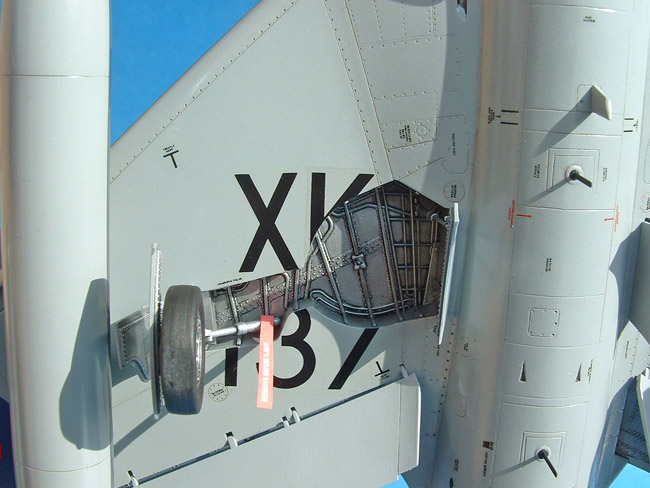Into the paint shop
Then it was onto the usual Tamiya airbrushed colours, which were given the hard edged camo appearance by masking them off with simple Tamiya tape (see your SMN Techniques Bank for more on this).
The painting was followed by a coat of Johnson’s Klear and then the panel line pastel wash treatment. This was home made from powdered chalk pastels mixed with water and a drop of washing up liquid. One thing I tried differently here was using a black wash on the dark colours of the topside, and a brown wash on the grey undersides… seems to have given a less stark, more subtle effect on the panel lines, and I’ll definitely do it again.
The one thing I will mention about this kit is the sheer number of decals used. I spent days covering the airframe with the stencils and national makings, and as far as I can see there are about 270 of them in all! Be prepared for some mammoth decaling sessions. I don’t know if they silvered at all, as I carried on over the top with a glossy finish, which makes it harder to tell than with matt.
Motion Potion
The fuel tanks were difficult to mask and paint due to the dark/light demarcation halfway down them – easy enough to do by eye on one tank, but trying to do four of them and get them all to line up? That was a difficult task, and required several attempts before I got it somewhere near right.
On the top surface of each wing is a small lump which on the real item was the explosive release housing for the outer wing tanks. Unfortunately this lies right in the middle of the roundel, so I had to add it after the roundel was in place and paint it to match. Fortunately Tamiya X-4 acrylic seems to be a good match for the blue on the roundel, so nothing looks glaringly obvious.
Undercarriage
The undercarriage was replaced with a white metal set, as I’d heard bad things about heavy models on plastic undercarts, and this was just a direct replacement with no fettling required. It was finished in Alclad Aluminium with a black pastel wash, and I must say I was pleased overall with the level of detail in the kit parts.

In fact, I had the Eduard PE set for this kit, and apart from the odd lever in the cockpit and the seatbelts, I didn’t use any of it, as the kit parts were sufficiently detailed not to need enhancing. The tyres were already flat-spotted for weight, and every single strut and connector on the undercarriage doors was included, and that sort of thing is usually firmly in PE territory. That’s got to be a recommendation!
Oh dear
Once the painting was complete, I unmasked the intakes only to find that the tape had become glued between the wings and the fuselage when they were joined. I couldn’t pull the tape free, and there was no access to cut it, so I was left with the only option – hide the intakes behind FOD covers. I had to scratch-build these, with no real references, but they look the part ok. They were made by painstakingly trimming paper to shape until it fitted the opening, making two plastic card copies, and finishing them off with two PE handles left over from my Airwaves Hurricane set.
I decided to add a pitot tube cover and some home made RBF streamers too, while I was at it. Never done that before, but they were easy to print out on my computer and cut into strips, attached with white glue at appropriate points. It was only afterwards that someone pointed out that these were American style streamers, the British ones being just diagonal red and white stripes. You live and learn…